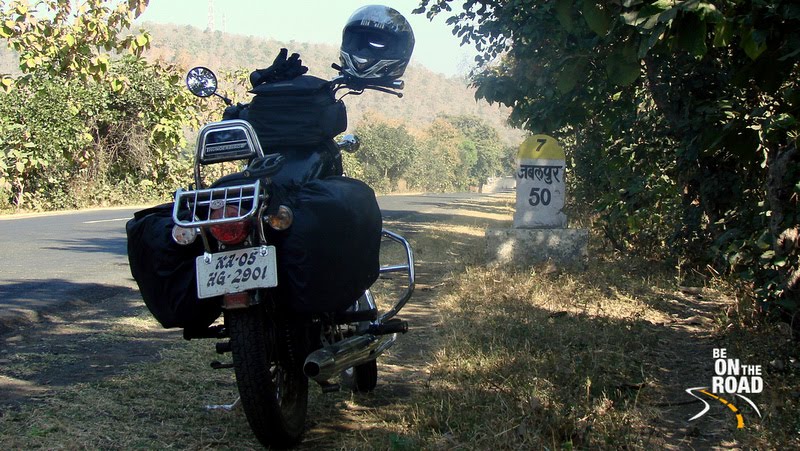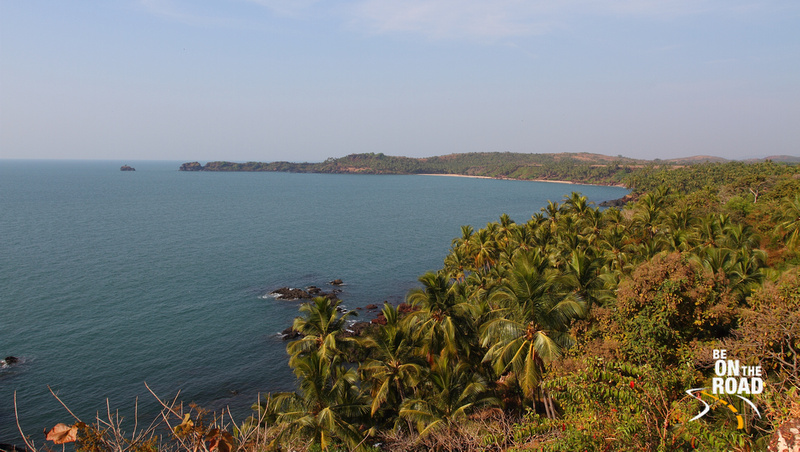
Since my all India motorcycle trip in 2008-2009, a lot of you have asked me how I went about this trip, how did I plan it, how did I fund it and more. And off late, these questions and enquiries have gotten more common. I am happy to see that a lot of people today are adventurous to explore India on a long motorcycle trip and to help such people, I am putting together this post of tips that will help you plan your long motorcycle trip in India. These are all tips that I have learnt from my personal experiences and mistakes. I hope they help you plan your dream motorcycle trip across India.
How to pick a Motorcycle?
A lot of people think a long motorcycle trip means getting themselves a Royal Enfield Bullet. While, the Royal Enfield motorcycles are great for long rides, I would recommend that you ride a motorcycle you are comfortable with and not a motorcycle that others recommend. Make sure that you have good riding experience on this type of motorcycle so that you will know how to control it in tough conditions.
How do I plan the itinerary?
India is a massive country and it will be a daunting task to build an itinerary. So, my recommendation in such cases would be to pick a theme of travel. For example, the golden quadrilateral highway, wildlife destinations of India, tribal locations in India, beaches of India, mountains of India and the likes. Picking such a theme would help you get an idea of the destinations and all you have to do then is chalk out the route.

What all do I need and how much will the trip cost?
Here’s a list of the various things that you would need to carry and an estimate of their costs. For a full packing list, click here.
1) Motorcycle: If you have a motorcycle well and good. If you have enough money, then buy a motorcycle of your choice (Royal Enfield, Hero Motorcycles, Yamaha, Harley Davidson, etc.). If you don’t have enough money, buy a used Royal Enfield Motorcycle. This will cost you between 30,000 to 60,000 INR depending on its condition.
2) Motorcycle Luggage Gear: More than the carrier system of loading luggage, I personally prefer a saddle bag and a magnetic tank bag. Both these can be easily removed from the motorbike and transported to the hotels easily. These can be bought online from Cramster for about 6,000 INR.
3) Crash Helmet: It is compulsory to wear a helmet in India and it is also one of the reasons I am able to write this post to you. Hence, never under estimate the importance of a good crash helmet. Buy a ISI approved helmet from one of the following brands (Vega, Steelbird, Globe, etc.). Make sure that the helmet is a good fit, allows enough air to go in, covers your entire head and teeth and has a clear visor. Do make sure that you put on a brand new clear visor without any scratches on your helmet before starting on your trip and change it at periodic intervals. This will enable you to see clearly during rain and during night drives. A good helmet should cost you between 3,000 to 5,000 INR.
4) Motorcycle Spares and Tools: It is absolutely important to carry some basic spares like a clutch cable, accelerator cable, tubes, battery fuses, headlight bulb, etc. You never know when and where you existing bike spares will run out. An estimate of such spares and tools is 10,000 INR. For a full list of spares, click here.

5) First Aid Kit: Like a lot of adventure travel, even motorcycling travel comes with its set of accidents. It is good to remain well prepared. Carry a full blown first aid kit. Such a first aid kit, if procured locally in India, should cost you between 3,000 to 5,000 INR.
6) Motorcycle Insurance: It is mandatory in India to carry a motorcycle Insurance policy. It will also come in handy in case of accidents. Personally, I use ICICI Lombard, but to get a better idea of all policy costs and benefits look up PolicyBazaar.com. Such a motorcycle policy should cost you between 1,000 to 2,000 INR.
7) Medical (Health) Insurance: It is good to be prepared for the worst case scenario when it comes to Motorcycle Travel. Carrying a health insurance policy makes you travel in peace. This will help you take care of any medical emergencies with ease. If you are a Indian citizen, look up PolicyBazaar.com for a list of health insurance providers. If you are a foreign national, do remember to carry an international health insurance and travel policy to take care of contingencies. This should cost you about 3,000 to 5,000 INR per month depending on cover taken and your age.
8) Gear for the Rider: This is purely optional and depends on the rider. I prefer to wear an armored jacket, riding gloves, knee guards, riding boots and a pair of sunglasses. While I prefer to buy my polaroid and shock proof pair of sunglasses at Sunglass Hut, the rest of the rider gear can be bought online at Cramster. A good pair of sunglasses can cost between 4,000 to 20,000 INR depending on brand and the rest of the rider gear can be bought for 10,000 INR.
9) Basic Motorcycle Repair Class: It is always good to know how to fix small repairs on your motorcycle as you might have to fix a flat, change cables, change your battery fuse, fix your chain, tighten your brakes, clean your air filter, etc in some remote corners without any help. I recommend taking a 7 day class with any mechanic or shop at least 2 months prior to your actual travel and practice this at home at least a couple of times. This class should cost you between 1,000 and 3,000 INR depending on the quality and schedule of your motorcycle mechanic.
10) Day to Day Expenses: These expenses can be broken into food, accommodation, petrol, water and miscellaneous.
Food: 200 INR and upwards per day depending on your standards.
Accommodation: 300 INR and upwards per day depending on your standards
Petrol (Gasoline): 500 INR per day assuming a daily ride of 200 kilometers
Water:

I am a foreign national. Is India safe? What pointers should I keep in mind?
India is mainly a safe country, but there are some things that one needs to keep in mind while travel India. I have elaborated more on these pointers in my article “India: Do you love it or hate it”.
Are there any best practices that I should keep in mind?
1) Always carry your driving license, motorcycle papers and motorcycle insurance with you at all times. If you are a foreign national, carry your international driving license. This will help you address questions asked by the traffic cops.
2) Stay within the prescribed speed limits to be on the safer side.
3) It is best to ride between sunrise to sunset. Most of the accidents in India take place in the night and it is also the time when a motorcycle rider has to bear the high beam lights of the bigger vehicles.
4) Motorcycle travel has to ability to dehydrate you a lot as the wind wicks away all the moisture. Always stay hydrated and carry enough drinking water with you at all times.
5) Take breaks (pit stops) every 60 minutes, even if it ends up being only a 5 minute break. This will help your muscles and joint get some movement and your motorcycle enough time to cool down.

6) Don’t fill gasoline when your engine is hot. Fill it in the morning when the engine is cold. This will help you minimize losses.
7) Always stretch your hands, legs, neck and hips during pit stops and at the end of your riding day. This will help you keep joint and muscle stiffness and injuries away.
8) Let your engine run at idling on the first start of the day for about 5 minutes before taking it out on the highway. This will help your motorcycle engine function smoothly.
9) Initially, you will feel like you can ride every day. But, based on my personal experience, I have seen my body react slower after 10 days of continuous riding. Hence, I would recommend enough rest between 2 riding days and that means more than just a 8 hour sleep.
10) It is good to carry a GPS and/or a phone with Google maps. But, I prefer more old school as it allows me to travel easily in regions without any internet or phone connectivity. An Eicher Road Atlas map book should be with you on your motorcycle at all times.
11) It is good practice to keep a riding limit of 200 kms per day. There can be some rare exceptions to the rule.
12) It is always good to carry some food (biscuits, nuts, chocolate bars, etc.) with you at all times. This will help you in times of need like a bike repair or any contingencies.
13) Fuel is a prized commodity in motorcycle travels. Hence, it is sensible to carry some spare fuel (5 to 10 liters) in some mountain areas and during days of strikes or local bandhs.
14) Stay abreast of local news and plan your ride accordingly.
15) Pack all your gear in trash bags and have a rain cover for yourself and your luggage. This will help you keep your stuff safe from rain, dust and dirt.
16) Ensure that the motorcycle’s tires and tubes are brand new before embarking on your journey. This will reduce punctures (flats) on the way.

How do I get a sponsor for my motorcycle trip?
This is a question that a lot of people have prior to starting on their motorcycle journey. I will answer this in simple terms. Create a crisp plan and pitch and use your contacts and networks to take to your sponsor. You need to have a good cause and show good marketing potential for your sponsor to give you financial help. If you are not lucky with this, you can try funding sites like kickstarter.com.
Continue Reading...




















 For the
For the 



























































